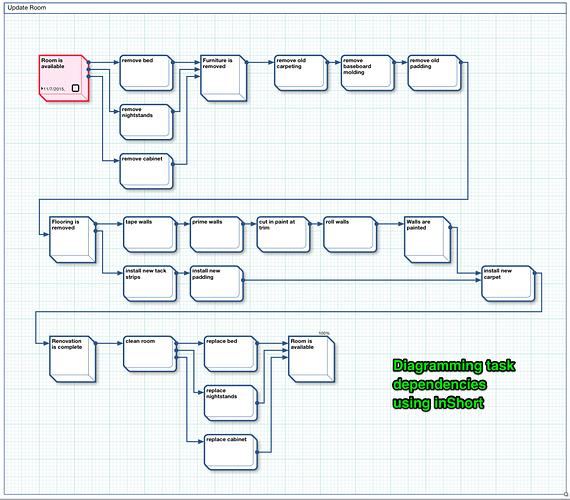I’m sure this has been addressed somewhere, but I’m having trouble figuring it out. I need to assemble a project in which the top level tasks are sequential, but the sub tasks can be performed in parallel. e.g. hanging new cabinets on a wall. I can’t hang the cabinet before the wall is ready. This must be done in sequence. But, the sub-tasks of preparing the wall and the sub-tasks of preparing the cabinets can be done in parallel. In a sequential project, though, the cabinet prep actions won’t become available until the wall is completed. I know I could use a SAL, but SALs would show everything being available and I’d lose the sequence piece of the top level actions. How might I solve this?
Do you mean something like this …
Update Room (sequential project)
-
Clean Out (parallel group)
– remove bed
– remove nightstands
– remove cabinet -
Prep Walls (sequential group)
– tape walls
– prime walls
– cut in paint at trim -
Paint (parallel group)
– paint left wall
– paint right wall
– paint back wall
– paint front wall -
Clean Up …
–
JJW
Close, but not quite … Consider this:
Do you mean something like this …
Update Room (sequential project)
Clean Out (parallel group)
– remove bed
– remove nightstands
– remove cabinet
Remove old flooring (sequential group)
– remove baseboard molding
– remove old carpeting
– remove old padding
Prep Walls (sequential group)
– tape walls
– prime walls
– cut in paint at trim
Paint (parallel group)
– paint left wall
– paint right wall
– paint back wall
– paint front wall
Install new flooring (sequential group)
– install new tack strips
– install new padding
– install new carpet
Clean Up …
While the joint compound from the “Prep Walls” group is drying, I could be installing new tack strip. But, in a sequential project, the tack strip task won’t show as available until after the painting is done.
~cd
Only you can determine what the task dependencies are. IME, these are often not worth perfecting 😊 . But if you want to proceed, every task-dependency failure can be traced (afaict) to a grouping failure. (We do not by nature or practice group tasks by actual dependency.) If you can “install new tack strip” before the group “Install new flooring” is available for execution, either the task does not belong in the group, or the group is improperly conceived. The simple way around this is to break your groupings down further. So perhaps “New flooring prep” and “Install carpet” could be substituted for “Install new flooring”. “New flooring prep” could be made parallel to “Prep & paint walls”, with the completion of each task necessary before “Install carpet” is available.
If you want to experiment with task dependencies or process flow in general, I heartily recommend the superb app “inShort”. It is a simple powerhouse. Here is very quick diagram of your process. For more on inShort, see the website.
As @KirbyKrieger notes, you have to determine and then set the sequences. Consider this instead …
Update Room (sequential)
- Clean Out Room (group)
- Remove Flooring (group)
- Prep Walls (group)
- Do Stuff (parallel group)
– Paint Walls (group)
– Prep Floor (group) - Finish Stuff (group)
–
JJW
I think I’m following you. Still not certain it’ll accomplish just what I want, but close enough for horseshoes and hand grenades.
Thanks gents!

